1. Blencowe H, Cousens S, Oestergaard MZ, Chou D, Moller AB, Narwal R, et al. National, regional, and worldwide estimates of preterm birth rates in the year 2010 with time trends since 1990 for selected countries: a systematic analysis and implications. Lancet. 2012; 379(9832):2162–2172. PMID:
22682464.

3. Liu L, Oza S, Hogan D, Chu Y, Perin J, Zhu J, et al. Global, regional, and national causes of under-5 mortality in 2000-15: an updated systematic analysis with implications for the Sustainable Development Goals. Lancet. 2016; 388(10063):3027–3035. PMID:
27839855.

4. Eichenwald EC, Stark AR. Management and outcomes of very low birth weight. N Engl J Med. 2008; 358(16):1700–1711. PMID:
18420502.

5. Manuck TA, Rice MM, Bailit JL, Grobman WA, Reddy UM, Wapner RJ, et al. Preterm neonatal morbidity and mortality by gestational age: a contemporary cohort. Am J Obstet Gynecol. 2016; 215(1):103.e1–103.14. PMID:
26772790.
6. Kim ER, Lee MS, Jin HS, Shim JW, Kim MH, Lim JW, et al. A multicenter study of preterm birth weight and gestational age-specific neonatal survival rate and causes of death. Korean J Perinatol. 2010; 21(4):369–376.
7. Li S, Zhang M, Tian H, Liu Z, Yin X, Xi B. Preterm birth and risk of type 1 and type 2 diabetes: systematic review and meta-analysis. Obes Rev. 2014; 15(10):804–811. PMID:
25073871.

8. Parkinson JR, Hyde MJ, Gale C, Santhakumaran S, Modi N. Preterm birth and the metabolic syndrome in adult life: a systematic review and meta-analysis. Pediatrics. 2013; 131(4):e1240–63. PMID:
23509172.

9. Saigal S, Doyle LW. An overview of mortality and sequelae of preterm birth from infancy to adulthood. Lancet. 2008; 371(9608):261–269. PMID:
18207020.

10. Romero R, Dey SK, Fisher SJ. Preterm labor: one syndrome, many causes. Science. 2014; 345(6198):760–765. PMID:
25124429.

11. Ko HS, Wie JH, Choi SK, Park IY, Park YG, Shin JC. Multiple birth rates of Korea and fetal/neonatal/infant mortality in multiple gestation. PLoS One. 2018; 13(8):e0202318. PMID:
30110380.

12. Nam SH, Lee JE, Choi SJ, Oh SY, Kim JH, Roh CR. Pregnancy outcome of cervical incompetence in twin versus singleton pregnancies. Korean J Perinatol. 2007; 18(2):149–153.
13. Asrat T, Lewis DF, Garite TJ, Major CA, Nageotte MP, Towers CV, et al. Rate of recurrence of preterm premature rupture of membranes in consecutive pregnancies. Am J Obstet Gynecol. 1991; 165(4 Pt 1):1111–1115. PMID:
1951524.

14. Esplin MS, O'Brien E, Fraser A, Kerber RA, Clark E, Simonsen SE, et al. Estimating recurrence of spontaneous preterm delivery. Obstet Gynecol. 2008; 112(3):516–523. PMID:
18757647.

15. Koullali B, Ravelli AC, Kazemier BM, Pajkrt E, Mol BW, Oudijk MA. 851: Recurrence rate of spontaneous preterm birth. Am J Obstet Gynecol. 2016; 214(1):Supplement. S443–S444.

16. Schaaf JM, Hof MH, Mol BW, Abu-Hanna A, Ravelli AC. Recurrence risk of preterm birth in subsequent singleton pregnancy after preterm twin delivery. Am J Obstet Gynecol. 2012; 207(4):279.e1–279.e7. PMID:
22917487.

17. Menzies R, Li AL, Murphy KE, Shah PS, Horn D, Barrett J, et al. Risk of singleton preterm birth after prior twin preterm birth: a cohort study. J Matern Fetal Neonatal Med. 2019.

18. Kazemier BM, Buijs PE, Mignini L, Limpens J, de Groot CJ, Mol BW, et al. Impact of obstetric history on the risk of spontaneous preterm birth in singleton and multiple pregnancies: a systematic review. BJOG. 2014; 121(10):1197–1208. PMID:
24899245.

19. Conde-Agudelo A, Romero R, Da Fonseca E, O'Brien JM, Cetingoz E, Creasy GW, et al. Vaginal progesterone is as effective as cervical cerclage to prevent preterm birth in women with a singleton gestation, previous spontaneous preterm birth, and a short cervix: updated indirect comparison meta-analysis. Am J Obstet Gynecol. 2018; 219(1):10–25. PMID:
29630885.

20. Grabovac M, Lewis-Mikhael AM, McDonald SD. Interventions to try to prevent preterm birth in women with a history of conization: a systematic review and meta-analyses. J Obstet Gynaecol Can. 2019; 41(1):76–88.e7. PMID:
30585167.

21. Cho GJ, Ouh YT, Kim LY, Lee TS, Park GU, Ahn KH, et al. Cerclage is associated with the increased risk of preterm birth in women who had cervical conization. BMC Pregnancy Childbirth. 2018; 18(1):277. PMID:
29970019.

22. Phillips C, Velji Z, Hanly C, Metcalfe A. Risk of recurrent spontaneous preterm birth: a systematic review and meta-analysis. BMJ Open. 2017; 7(6):e015402.

23. Laughon SK, Albert PS, Leishear K, Mendola P. The NICHD Consecutive Pregnancies Study: recurrent preterm delivery by subtype. Am J Obstet Gynecol. 2014; 210(2):131.e1–131.e8. PMID:
24036403.

24. Ouh YT, Park JH, Ahn KH, Hong SC, Oh MJ, Kim HJ, et al. Recurrent risk of preterm birth in the third pregnancy in Korea. J Korean Med Sci. 2018; 33(24):e170. PMID:
29892210.

25. Rafael TJ, Hoffman MK, Leiby BE, Berghella V. Gestational age of previous twin preterm birth as a predictor for subsequent singleton preterm birth. Am J Obstet Gynecol. 2012; 206(2):156.e1–156.e6. PMID:
22098669.

26. Menard MK, Newman RB, Keenan A, Ebeling M. Prognostic significance of prior preterm twin delivery on subsequent singleton pregnancy. Am J Obstet Gynecol. 1996; 174(5):1429–1432. PMID:
9065107.

27. Facco FL, Nash K, Grobman WA. Are women who have had a preterm twin delivery at greater risk of preterm birth in a subsequent singleton pregnancy? Am J Obstet Gynecol. 2007; 197(3):253.e1–253.e3. PMID:
17826408.

28. Committee on Practice Bulletins—Obstetrics, The American College of Obstetricians and Gynecologists. Practice bulletin no. 130: prediction and prevention of preterm birth. Obstet Gynecol. 2012; 120(4):964–973. PMID:
22996126.
29. Meis PJ, Klebanoff M, Thom E, Dombrowski MP, Sibai B, Moawad AH, et al. Prevention of recurrent preterm delivery by 17 alpha-hydroxyprogesterone caproate. N Engl J Med. 2003; 348(24):2379–2385. PMID:
12802023.

30. Tita AT, Rouse DJ. Progesterone for preterm birth prevention: an evolving intervention. Am J Obstet Gynecol. 2009; 200(3):219–224. PMID:
19254577.

31. Cavoretto P, Candiani M, Giorgione V, Inversetti A, Abu-Saba MM, Tiberio F, et al. Risk of spontaneous preterm birth in singleton pregnancies conceived after IVF/ICSI treatment: meta-analysis of cohort studies. Ultrasound Obstet Gynecol. 2018; 51(1):43–53. PMID:
29114987.

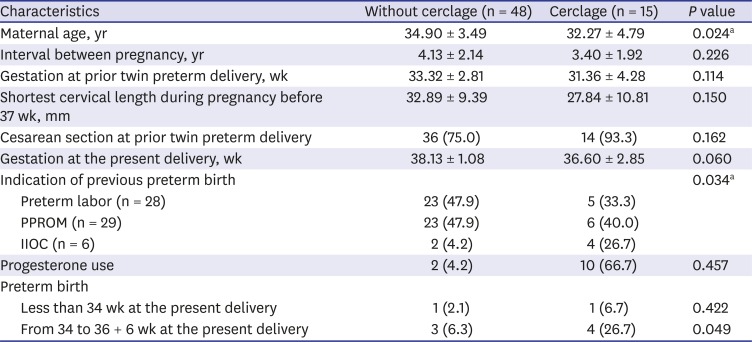
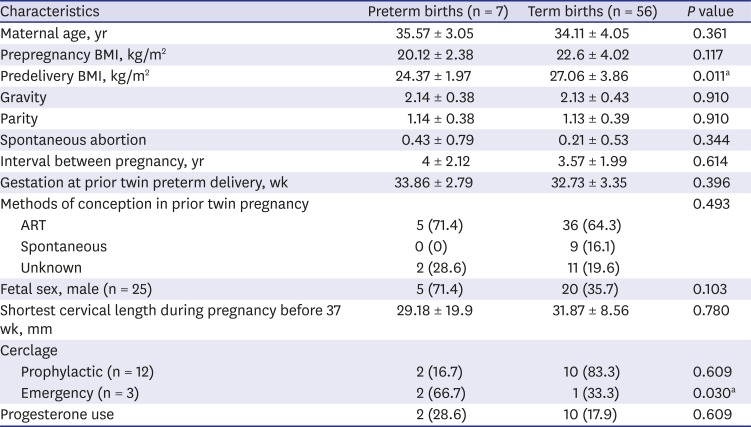
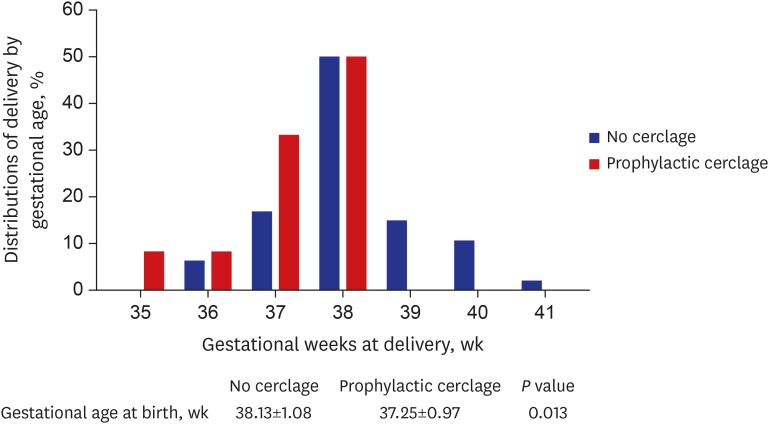





 PDF
PDF Citation
Citation Print
Print



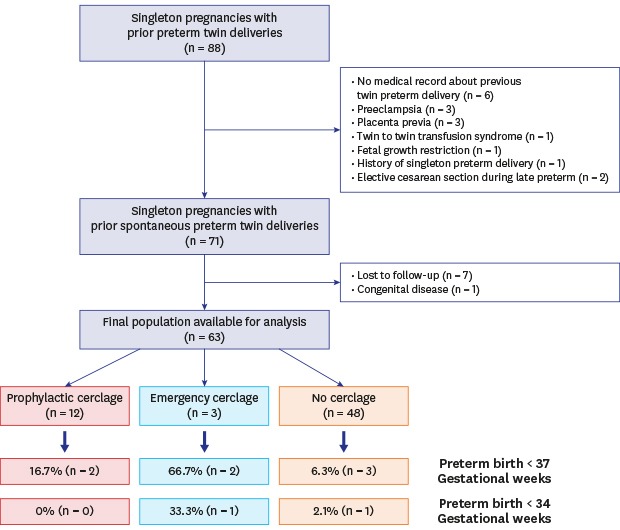
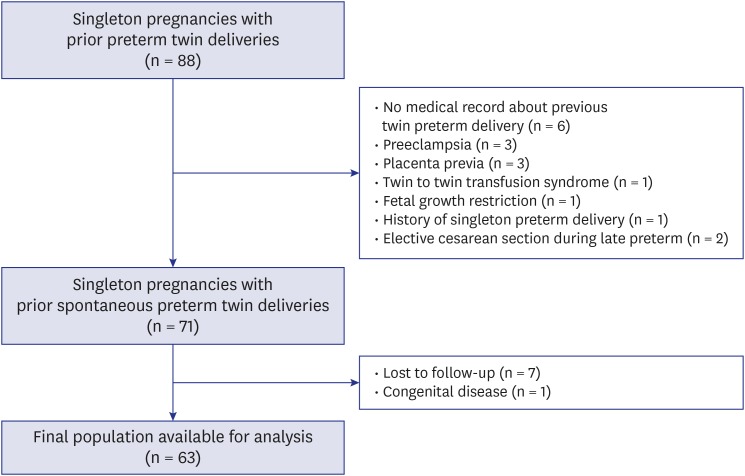
 XML Download
XML Download